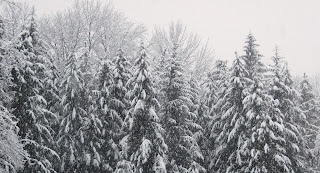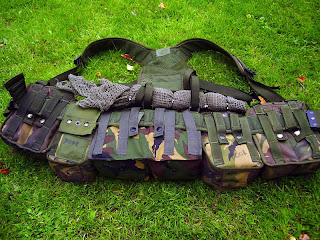For your consideration:
CLOTHING
WOOL PANTS & SUSPENDERS (treated with paraffin)
HEAVY WOOL SOCKS
POLYPROPALENE UNDERWEAR (top and bottom)
TURTLE NECK (LIGHT WOOL) SWEATER & FLEECE
WATER PROOF - INSULATED FELT PACKS OR RUBBER BOOTS.
SNOW SHOES
 Laced or Grommet designed snow shoes composed of an aircraft grade tubular aluminum frame with composite materials that will not swell with moisture. They are strong, they are reliable and I have walked many miles in the coastal mountains in these snow shoes. Harnesses must be sturdy for lateral and horizontal support to allow effective walking up and down icy hills. Harnesses must be supported by a hinge rod, heel claw and a heel plate to permit a positive grip.
Laced or Grommet designed snow shoes composed of an aircraft grade tubular aluminum frame with composite materials that will not swell with moisture. They are strong, they are reliable and I have walked many miles in the coastal mountains in these snow shoes. Harnesses must be sturdy for lateral and horizontal support to allow effective walking up and down icy hills. Harnesses must be supported by a hinge rod, heel claw and a heel plate to permit a positive grip.HEAD
 Raincoast Hardhat (Brim 360o). These helmets were made for working in the bush. They will keep your head dry, water off the back of your neck, lamps can be affixed to these helmets and there is a wide assortment of winter liners and harnesses to choose from. The B.C. Worker’s Compensation Board prohibits industry workers from entering a work site with over-head hazards without approved safety protection equipment. In the Forest Industry you must wear a Hi-visibility hard hat on your head at any time you are within proximity to the tree line. I am completely sold on this product for use in the forests of coastal BC. I can tell you that wearing a hard hat – especially in winter climes while under a forest canopy is an essential piece of kit. I have been hit by snow & ice falling out of the crowns of these trees and I can tell you from personal experience that I probably would not have walked out of the bush that day if it were not for my hard hat. Canadian Rangers are not insured by WCB and therefore we are not required to wear hard hats while employed by the Canadian Armed Forces, however it is my due diligence to highly recommend this safety product to you. More information on this recommendation can be found in an article I published in 2006. Safety Equipment Recommendation for Canadian Rangers
Raincoast Hardhat (Brim 360o). These helmets were made for working in the bush. They will keep your head dry, water off the back of your neck, lamps can be affixed to these helmets and there is a wide assortment of winter liners and harnesses to choose from. The B.C. Worker’s Compensation Board prohibits industry workers from entering a work site with over-head hazards without approved safety protection equipment. In the Forest Industry you must wear a Hi-visibility hard hat on your head at any time you are within proximity to the tree line. I am completely sold on this product for use in the forests of coastal BC. I can tell you that wearing a hard hat – especially in winter climes while under a forest canopy is an essential piece of kit. I have been hit by snow & ice falling out of the crowns of these trees and I can tell you from personal experience that I probably would not have walked out of the bush that day if it were not for my hard hat. Canadian Rangers are not insured by WCB and therefore we are not required to wear hard hats while employed by the Canadian Armed Forces, however it is my due diligence to highly recommend this safety product to you. More information on this recommendation can be found in an article I published in 2006. Safety Equipment Recommendation for Canadian Rangers VINYL SURGICAL GLOVES or DISH GLOVES
 There are several items that are heavy that you don’t need to carry on your back. The belt rig is intended to expand your access to the tools you often need to access and move the weight of heavier items from your back onto your hips. Items such as water, hatchet, bush knife, pruning saw, karabiner, .303 British ammunition, etc... I have tried several different belt designs but have only recently found a belt rig system that works well for me. Things to look for are clasps that will slip loose under strain and belts that will bind into your sides while under weight. The durable, comfortable and very affordable Canadian Tire Mastercraft Basic Padded Belt has an expanded surface area to distribute the weight across your mid-section and a clasping system that does not slip. At $14.99 you can’t go wrong and you find that your comfort of working in the bush is significantly improved.
There are several items that are heavy that you don’t need to carry on your back. The belt rig is intended to expand your access to the tools you often need to access and move the weight of heavier items from your back onto your hips. Items such as water, hatchet, bush knife, pruning saw, karabiner, .303 British ammunition, etc... I have tried several different belt designs but have only recently found a belt rig system that works well for me. Things to look for are clasps that will slip loose under strain and belts that will bind into your sides while under weight. The durable, comfortable and very affordable Canadian Tire Mastercraft Basic Padded Belt has an expanded surface area to distribute the weight across your mid-section and a clasping system that does not slip. At $14.99 you can’t go wrong and you find that your comfort of working in the bush is significantly improved.Ultimately my favorite waist rig is the British P.L.C.E. belt order. The system disperses weight evenly across your hips through a cushioned mesh barrier upon which the belt rests. This stops the weight from digging into your flesh and still provides room for field knife, hatchet and a pruning saw. The system also rides fairly low and allows space for the user to don a ruck if required. System comes complete with a yoke and suspenders. I have moved to this system and I am very satisfied and very comfortable.
 Utility vests are rugged pieces of kit that allow you to access frequently required tools that the Canadian Ranger regularly requires. My personal favourite is a Cruising Vest which is covered with accessible pockets and pouches. These are usually constructed of Cotton or 500 Denier Nylon Cordura. I recommend Cordura construction as it will repel water rather than soak up water like cotton. These vests can be used to carry all of the components you need in a 24hr pack and can be used to supplement your 3 day pack. Many Rangers prefer tactical vests however in all practicality the cruising vest is probably better suited to Rangers for working in the bush. The pouches and pockets are much larger and the vest is much more comfortable to wear. Most of our operations are 'Overt' not 'Covert' so bright colours can be of benefit.
Utility vests are rugged pieces of kit that allow you to access frequently required tools that the Canadian Ranger regularly requires. My personal favourite is a Cruising Vest which is covered with accessible pockets and pouches. These are usually constructed of Cotton or 500 Denier Nylon Cordura. I recommend Cordura construction as it will repel water rather than soak up water like cotton. These vests can be used to carry all of the components you need in a 24hr pack and can be used to supplement your 3 day pack. Many Rangers prefer tactical vests however in all practicality the cruising vest is probably better suited to Rangers for working in the bush. The pouches and pockets are much larger and the vest is much more comfortable to wear. Most of our operations are 'Overt' not 'Covert' so bright colours can be of benefit. I have owned many axes and I highly recommend the Wetterlings small hunting axe. They are an excellent product and I have used this one axe extensively, for a multitude of applications, over the last eight years. The only thing I have replaced is the sheath which I found to be insufficiently durable. The head has remained firm and the blade can be made razor sharp. http://www.wetterlings.com/
I have owned many axes and I highly recommend the Wetterlings small hunting axe. They are an excellent product and I have used this one axe extensively, for a multitude of applications, over the last eight years. The only thing I have replaced is the sheath which I found to be insufficiently durable. The head has remained firm and the blade can be made razor sharp. http://www.wetterlings.com/ PRUNING SAW
TARP
BUG NET


















 I have chronographed variability in muzzle velocity within some IVI lots of +/- 120 fps with 175 grain Ball (FMJBT - full metal jacket boat tail) Mk8Z ammunition . That is a severe velocity spread (or standard deviation) and indicates possible issues with Quality Control at Industries Valcartier Inc. Having said that these were older lots from the early 1990’s. The good news is that IVI is now owned by
I have chronographed variability in muzzle velocity within some IVI lots of +/- 120 fps with 175 grain Ball (FMJBT - full metal jacket boat tail) Mk8Z ammunition . That is a severe velocity spread (or standard deviation) and indicates possible issues with Quality Control at Industries Valcartier Inc. Having said that these were older lots from the early 1990’s. The good news is that IVI is now owned by 

